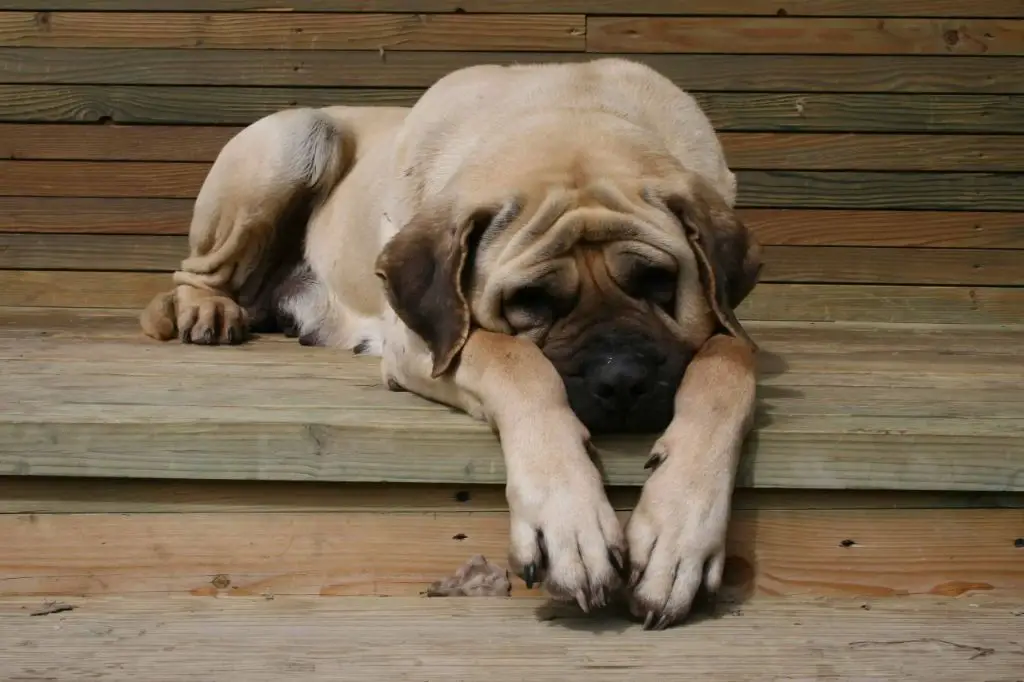Introduction
Many people love big dogs for their imposing size and affectionate personalities, but are hesitant to adopt one due to concerns about exercise needs. However, some large dog breeds actually require less physical activity than their smaller counterparts. This article will provide an overview of low-maintenance big dogs that are less active and don’t need as much exercise.
Great Danes
Despite their size, Great Danes are gentle giants and couch potatoes at heart. They require only average exercise, typically 30-60 minutes per day (1). Great Danes are perfectly content with a couple short, moderate-paced walks each day or some play time in a spacious, fenced yard. However, these massive dogs reach their full adult size by 18 months, though they aren’t considered full grown until age 3. To avoid putting too much stress on their developing bones and joints, activities like running, jumping, fetching, or climbing stairs should be avoided until a Great Dane is fully grown. Keeping their exercise moderate will fulfill their needs. Their ideal home is calm and quiet with ample room to lounge (2).

Mastiffs
Mastiffs are one of the largest dog breeds, with some varieties weighing over 200 pounds. Despite their massive size, mastiffs require less exercise than many smaller breeds. According to this source, mastiffs only need about 30 minutes to an hour of exercise per day. This exercise can be broken up into shorter, less frequent walks throughout the day.
The lower exercise needs of mastiffs are due to their calm temperament and tendency to be somewhat lazy when not working. Mastiffs were bred to be guard dogs and don’t require intense daily exercise as long as their other needs are met. With their giant size, mastiffs are also prone to injuries and joint problems that can be exacerbated by over-exercising. Keeping walks short but regular allows mastiffs to stay fit and healthy.
In addition to short daily walks, mastiffs enjoy having a large fenced yard where they can wander and patrol at their own leisure. The breed is content with being mildly active around the house when not napping. Overall, the mastiff’s exercise needs are quite minimal compared to other dogs of the same size.
Saint Bernards
Saint Bernards are one of the most popular large dog breeds that require relatively little daily exercise. According to PetKeen, Saint Bernards only need a moderate amount of exercise daily as long as you do not overdo it. Their exercise needs are modest and they are satisfied with short, 30 minute walks per day. Avoid having them jump down from heights or overly strain their joints. Due to their large size and tendency towards joint problems, it’s best to limit high-impact activities. A couple leisurely walks and some playtime in the yard each day is sufficient to keep a Saint Bernard healthy and content.

Greyhounds
Greyhounds are one of the laziest dog breeds that require little exercise. Despite their reputation for being fast runners, greyhounds are actually couch potatoes at heart. According to How Much Exercise Do Greyhounds Need? The Surprising Truth!, greyhounds only need one or two short 10-15 minute walks per day. They enjoy lounging around the house and short bursts of energy rather than prolonged physical activity.
Many greyhound owners are surprised to learn that these athletic looking dogs are content with limited exercise as long as their basic needs are met. Greyhounds build up energy quick and tire fast during walks or playtime. A short jog or play session in the yard is often sufficient to meet their exercise requirements. Extensive walks or hikes are not necessary for this breed.
According to greyhound owners on Reddit, retired racing greyhounds are especially lazy and low maintenance when it comes to exercise. After years on the racetrack, they are happy to lounge around the house and only need brief daily walks. Overall, the greyhound’s exercise needs are much lower than their sleek physique suggests.
Newfoundlands
Newfoundlands are one of the largest breeds of dog, with males reaching 150 lbs or more. Despite their giant size, they are known as gentle giants and make great family pets. Newfoundlands do not require a lot of exercise compared to other large breeds [1].

A Newfoundland will be happy with 30-60 minutes of exercise per day. Short walks or jogs of 15-20 minutes twice daily will meet their needs. Newfoundlands also love playing fetch or frisbee. However, it’s important not to overexercise a Newfoundland puppy before they are fully grown, to avoid damaging their joints [2].
Newfoundlands are low energy and quite lazy indoors. They make great companions for people with limited mobility or health issues, as they require minimal exercise. Overall, Newfoundlands are one of the best large breed dogs for those looking for a more relaxed and sedentary pet.
Bullmastiffs
Bullmastiffs are one of the more inactive large dog breeds that require little exercise. Despite their large size, bullmastiffs only need a moderate amount of exercise each day to stay healthy and content.
A 30-45 minute walk or play session per day is usually sufficient for most bullmastiffs. Their exercise needs tend to decrease as they get older as well. Bullmastiffs enjoy going for leisurely walks and having a place to run around, but they are generally not high energy dogs.
Relatively inactive, low intensity exercise is perfect for bullmastiffs. Their massive size makes them prone to overheating, so it’s important not to overexercise them. Short, gentle walks and some time to explore in a yard or dog park are ideal activities. High impact exercise like jogging can put too much stress on their joints.
Since bullmastiffs don’t require a ton of activity, they make good pets for those with more sedentary lifestyles. Their exercise needs can easily be met with one or two daily walks. However, bullmastiffs do need regular opportunities to stretch their legs and should not be left alone for prolonged periods without activity.
With their laidback temperament and moderate activity requirements, bullmastiffs are one of the large breeds that thrive with just a little bit of daily exercise.
English Mastiffs

The large and powerful English Mastiff is an excellent choice for people looking for a gentle giant. Weighing between 100-200 pounds, they are content with short daily walks to meet their exercise needs. According to Dog-Learn, “Though they’re not too energetic, these dogs are very muscular and athletic–so English Mastiff exercise needs are moderately high. Owners need to provide short walks or jogs to meet their daily exercise requirements.” With proper exercise, Mastiffs are low maintenance companions that enjoy lounging around the house.
Great Pyrenees
The Great Pyrenees is a large breed that originates from the mountains between France and Spain. Despite their large size, Great Pyrenees dogs require less exercise than many other big breeds. According to Canna-Pet, the exercise needs of a Great Pyrenees are relatively low, with about 30 minutes of activity per day being sufficient.
The Great Pyrenees was bred to be a livestock guardian dog, working independently and patrolling large areas. Because of this history as an independent outdoor worker, Great Pyrenees are not as demanding of human attention and structured exercise as some dogs. They are happiest with access to a large, safely enclosed yard where they can patrol and watch over their territory.
The Great Pyrenees can adapt to being calm indoor companions who are satisfied with moderate daily walks, making them a good choice for those looking for a giant breed that requires little active exercise.
Conclusion
In summary, there are several large dog breeds that require relatively little exercise compared to other breeds. Some examples include the Saint Bernard, Bullmastiff, Great Dane, Greyhound, and Newfoundland. These gentle giants tend to be calm, easygoing, and content with shorter, less frequent walks and playtimes. Their energy levels and exercise needs make them well-suited for households or owners with more sedentary lifestyles. When properly trained and socialized, these large low-energy dogs can make wonderful companions and family pets in homes without huge yards or very active owners.
Key traits that allow these breeds to thrive with less exercise include their naturally calm temperaments, lower activity levels, and minimal excitability. Their large size also means they remain lower energy even as adults. While they still require some daily exercise and playtime, substantially less than many other breeds. Providing enrichment through toys and quality time is also important. With proper care and attention, the low-energy large breeds mentioned can flourish in households with limited space or less active owners.
